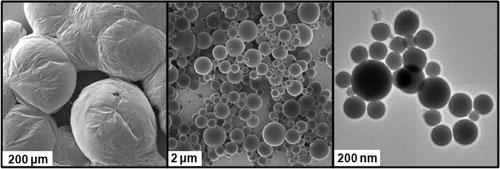| Nov 04, 2011 |
Researchers develop a facile method for preparing liquid-phase metal alloy nanoparticles
|
|
(Nanowerk News) In a paper to be published in Nano Letters ("Directing Substrate Morphology via Self-Assembly: Ligand-Mediated Scission of Gallium–Indium Microspheres to the Nanoscale"), researchers demonstrate a facile method for preparing liquid-phase metal nanoparticles, composed of a eutectic gallium-indium alloy.
|
 |
| Liquid-phase eutectic gallium–indium (EGaIn) alloy nanoparticles.
|
|
Particle formation is directed by molecular self-assembly and assisted by sonication. As the bulk liquid alloy is ultrasonically dispersed, fast thiolate self-assembly at the alloy surface protects the material against oxidation. The choice of self-assembled monolayer ligand directs the ultimate size reduction in the material; strongly interacting molecules induce surface strain and assist particle cleavage to the nanoscale.
|
|
Transmission electron microscopy images and diffraction analyses reveal that the nanoscale particles are in an amorphous or liquid phase, with no observed faceting. The particles exhibit strong absorption in the ultraviolet (~200 nm), consistent with the gallium surface plasmon resonance, but dependent on the nature of the particle ligand shell. These materials will be applied to print metal contacts and with further reactions to print semiconductors and solar cells.
|
|
The research team, led by Paul S. Weiss, represents a collaboration of investigators from the California NanoSystems Institute, the department of Chemistry and Biochemistry and department of Materials and Engineering at UCLA, along with the department of Chemistry at The Pennsylvania State University and department of Chemistry at Dickinson College.
|

